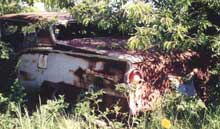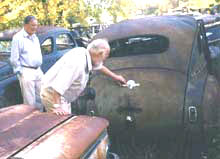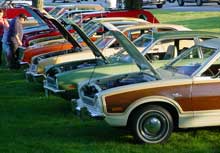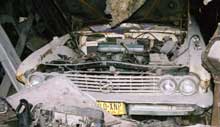A Tip of the Cap
This car sat for years beside the road in Hyannis, Massachusetts, on Cape Cod. Car spotters easily identified it as a 1957 Ford. Closer inspection reveals an unusual fuel door location and a distinctive roofline, both hallmarks of the Skyliner retractable hardtop, a "new kind of Ford" that year. The Skyliner returned for the 1958 season, and one final time in 1959, after which it departed the catalog. The unusual roof mechanism, in which the "trunklid" opened from the front to swallow the roof, carried on in 1958, '59 and '60 "squarebird" Thunderbirds, but with a soft top, and had a final fling on the 1961-67 Lincoln Continental convertible, of which this 1962 is a good example.
The collapsible hard top was not meant to be a Ford feature at all. Intended for the 1956 Continental Mk II, an unbadged Lincoln, it was judged too costly for a limited production car. It was hoped that the greater production volume of the Ford would better amortize the development costs. Ford had a couple of Mk IIs softtop-converted by Hess and Eisenhardt (now armored car constructor Centigon) in 1957, but the model never entered production.
It is well that the Skyliner was touted as a new kind of Ford, as it wasn't a new kind of car. Peugeot had a retracting hardtop on the Éclipse model in the 1930s. Designed by French dentist Georges Paulin, the system was built into a few Peugeot 301 models in 1934 by Parisian coachbuilder Marcel Pourtout. Later Éclipse décapotables (crudely translated as "able to remove the cap") were built on the larger 601 model and finally a series of nearly 500 on the 402. The Éclipse is fondly remembered at Peugeot, so much so that the company has put modern versions, the 206CC and 307CC into production recently, although Mercedes-Benz would have you believe the SLK is the only such collapsible in the world.
But even Peugeot was not the first with a retracting hard top. In 1922, B.B. Ellerbeck of Salt Lake City, Utah, built one on a Hudson Super Six. Not as sophisticated as either the Eclipse or the Skyliner, its top had the same curvature as the rear of the roadster body. It merely pivoted back and down. A clever hatch in the top allowed the use of the rumble seat when the roof was down. a feature missing on Peugeot and Ford.
At $2,942, the 1957 Skyliner was nearly 20 percent more expensive than the canvas-roofed Sunliner. The price premium, the complexity of the top mechanism, and the nearly-unreachable luggage space combined to limit sales to barely a quarter of Sunliner volume. At 20,766 units, though, the Skyliner is not the rarest '57 Ford. The Fairlane Town Victoria achieved but 12,695 and the Custom Business Sedan, a "Tudor" without a rear seat, only 6,888.




